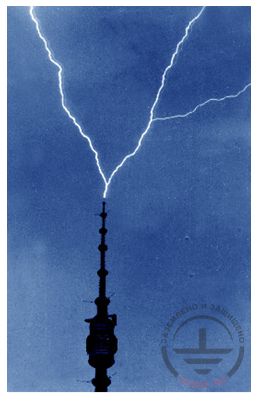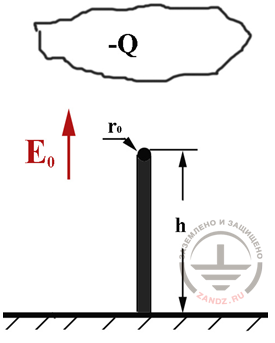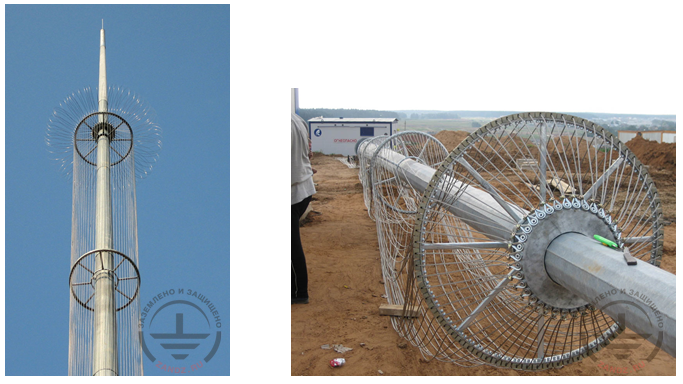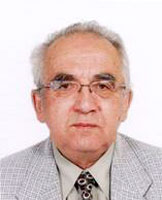From the series of articles "Lightning protection of oil and gas facilities".
4.1. The mechanism of pending charges
A lightning discharge is demonstrated in fig. 20. The Ostankino tower was struck "by an inverted lightning." It started from the top of the tower and rushed to a charged cell of a thunderstorm cloud. The experts call such discharges upward, in contrast to the traditional downward, which develop from the cloud to the ground.

Figure 20. Picture of an upward lightning to the Ostankino television tower
Lightning always branches in the direction of motion, so the direction of its development is well distinguishable. The explanation of the nature of upward lightning does not cause any problems. The charge of a thundercloud creates quite a decent electric field at the ground. On unshielded surface it can reach E0 = 20 - 50 kV/m. In half a kilometer height of the tower H can gain voltage U0 = E0H0 of up to 25 MV.
4.2. Protection means
AD-34.21.122-87 prescribes mandatory protection of the area of combustible gas emissions from the contact with the lightning channel. For this purpose, it should always be included into the lightning rods protection zone together with the tank. This is not bad, though useless, because not only contact with the lightning channel, but also almost any pending discharge can bring to the gas ignition. They can appear from the side surface of the lightning rod, from the fence on the tank roof, even from the structural parts of the vent valve of a small radius, where the external electric field is significantly magnified. Estimation of the effect is quite simple.

Figure 21. To the estimation of the electric field at the top of the grounded electrode
Let the storm cloud create an electric field at the ground with the intensity E0 (for simplicity, - uniform), in which there is an object with the height h with the top of the radius r0. The potential of the lightning field at the top is U0(h) = -E0h (the minus sign considers the direction of the vector E0 in fig. 21). However, the object is grounded, and that is why its potential is equal to zero. For that, Qind charge should be imposed on the top at the expense of electrostatic induction, which will bring the total capacity to zero by its field:

Here, the potential of the induced charge of the top is registered like for a point charge. It gives the following expression for the charge induced on the top

The field of the induced charge directly at the top is equal to

It is in KE = h / r0 times greater than the electric field of a thunderstorm cloud in place of object location. If to hold a calculation considering the induced charge and on side side surface of the rod electrode of the same radius r0, you get the value of 2 times smaller:

but still the effect of the lightning field enhancement will be very expressive. For example, when E0 = 20 kV/m the air ionization threshold the electrode top with the radius r0 = 10 mm will be reached at the height h = 1.5 m. Almost any construction heterogeneity of a small radius, sharp corners on the vent valve, air terminal rod (including its side surface), tank guard made of steel corners, etc. can act as an "electric lighter". Installation of lightning rod does not eliminate this danger.
Means of limiting electric field intensity are well known. It is necessary to increase the radius of curvature of thin building structures. It is necessary to start with the lightning rod, especially if its air terminal is located in the gas emission zone or very close to it. Lightning protection standard of "Gazprom" JSC offers a detailed calculation of the radius of a rod lightning rod that guarantees intrinsic safety. In typical situations, it is a radius of tens of centimeters. A specialist in the field of mechanics can easily calculate the wind load on such a structure and its foundation. For the northern regions with strong winds the values are very impressive. To reduce them, proposed a lightning rod with the split side surface (fig.22). Made of thin steel cables, it is more "transparent" for the air flow, but it almost equally effectively shields the electric field and solid metal.

Figure 22. Lightning rod with the split side surface
Manufacture of such lightning conductors was started. The only pity is that their installation does not solve the problem completely. The split surface will reduce the strength of the electric field to a safe level, but it is not able to influence the conditions of the pending discharges from other structural elements of small radius of curvature. In theory it is possible to screen all of them without exception. But what to do with a bird sitting on the tank fence, or with a metal shovel, which was accidentally forgotten on the roof?
Universal screening of all potentially dangerous places doesn't fit the category of design solutions that ensure high reliability. It is more correct to fight not with bursts of gas emissions over the tanks, but with their dangerous consequences. There is no other option than to create reliable flame-arresters, that will completely cover the possibility of flame penetration into the interior of the tank.
E. M. Bazelyan, DEA, professor
Energy Institute named after G.M. Krzyzanowski, Moscow
Useful materials:
- Series of articles about lightning protection for beginners
- Series of webinars about grounding and lightning protection with Professor E. M. Bazelyan
- Elements of external lightning protection
- Consultations on the selection, design and installation of grounding and lightning protection systems
Related Articles:
 Lightning protection of oil and gas facilities
Lightning protection of oil and gas facilities
 Fixation for the rod lightning rod to the chimney (stainless steel)
Fixation for the rod lightning rod to the chimney (stainless steel)
.jpg) Clamp on the ridge for the down conductor with its elevation above the clamp to 30 mm (copper)
Clamp on the ridge for the down conductor with its elevation above the clamp to 30 mm (copper)
-7.jpg) Clamp to the air terminal - mast for down conductors (stainless steel)
Clamp to the air terminal - mast for down conductors (stainless steel)



